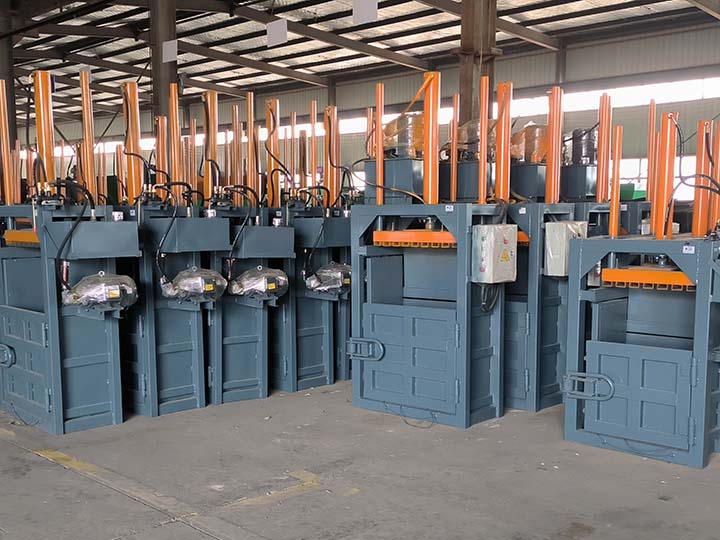Automatic balers are versatile machines used in various industries for efficient material handling. Let’s explore the types, features, benefits, and applications of automatic balers.

Types of Automatic Baler
- Vertical Balers: These balers have a vertical compression chamber and are suitable for smaller spaces. They are commonly used for materials such as cardboard, paper, plastics, and textiles.
- Horizontal Balers: Featuring a horizontal compression chamber, horizontal balers are designed for handling larger quantities of materials. They can process a wide range of materials, including cardboard, paper, plastics, textiles, and metals.
- Two-Ram Balers: These balers have two hydraulic rams, allowing for greater flexibility in bale size and density. They can handle various materials, including bulky and non-uniform items, and are often equipped with advanced control systems.
- Closed-End Balers: Closed-end balers feature a closed compression chamber and are specifically designed for processing plastics and lightweight recyclables. They create highly dense bales, occupying minimal storage space.
Features of Automatic Balers
- Easy-to-Use Controls: Automatic balers are equipped with user-friendly control panels that allow operators to set parameters and monitor the operation. These controls make it simple to adjust settings and ensure smooth and safe operation.
- Automated Feeding Systems: Balers feature automated feeding systems, such as conveyor belts or hoppers, that streamline the material input process. These systems enable materials to be smoothly and continuously fed into the baler, reducing the need for manual intervention and improving overall efficiency.
- Compression Chamber: Automatic balers have a compression chamber where materials are loaded and compressed into compact bales. The chamber is designed to accommodate different material sizes and types, providing flexibility in handling various materials.
- Binding Mechanisms: To secure the bales, automatic balers utilize binding mechanisms such as wires, straps, or other fastening methods. These mechanisms automatically fasten the bales, eliminating the need for manual tying or strapping and ensuring that the bales remain tightly packed during handling and transportation.
- Safety Features: Automatic balers prioritize operator safety by incorporating safety features into their design. These features may include emergency stop buttons, safety guards, and sensors that detect any potential hazards or irregularities during operation. They help prevent accidents and ensure a safe working environment.
Applications of Automatic Balers
- Recycling Facilities: Automatic balers play a crucial role in recycling plants. They are utilized to process materials like cardboard, paper, plastics, and metals. Balers compress these materials into dense bales, making them easier to store, transport, and recycle.
- Manufacturing Industries: Automatic balers are employed in manufacturing facilities to handle and recycle waste materials generated during production processes. These may include packaging materials, scraps, and other byproducts. Balers ensure efficient waste management and help reduce the environmental impact of manufacturing operations.
- Warehouses and Distribution Centers: Balers are valuable assets in warehouses and distribution centers. They efficiently package materials such as cardboard boxes, packaging materials, and pallets, optimizing storage space and streamlining the handling and transportation of goods.
- Retail and Supermarkets: Automatic balers find applications in retail environments and supermarkets. They are used to manage waste materials like cardboard packaging, plastic containers, and packaging films. Balers help compact and organize these waste materials, facilitating their proper disposal or recycling.
- Textile Industry: The textile industry benefits from automatic balers for compressing and packaging textiles, including clothing, fabrics, and fibers. Balers ensure efficient handling and transportation of these materials, enhancing storage space utilization and facilitating recycling or disposal.
- Waste Management Facilities: Automatic balers are integral to waste management facilities. They assist in processing various types of waste materials, compacting them into manageable bales. This simplifies waste transportation, reduces storage requirements, and contributes to effective waste management practices.
- Logistics and Transportation: Automatic balers play a role in logistics and transportation operations. By compacting materials into bales, they optimize space utilization in trucks, containers, or storage areas. This allows for more efficient loading, reduces transportation costs, and maximizes delivery capacity.
- Environmental Initiatives: Automatic balers support environmental initiatives by promoting efficient recycling and waste management practices. They contribute to minimizing waste volume, reducing landfill usage, and conserving resources through the recycling of materials.
- Hospitality and Food Service: Balers are employed in the hospitality and food service industry to manage waste materials such as cardboard boxes, food packaging, and plastic containers. By compacting these materials into bales, balers facilitate organized waste disposal and recycling processes.
- Municipalities and Public Facilities: Automatic balers find applications in municipal waste management and public facilities. They assist in managing and compacting various waste materials generated in public spaces, parks, or municipal buildings. Balers contribute to maintaining clean and organized environments while optimizing waste management practices.
Summary
Automatic balers help with material handling in various industries. They offer efficiency, space optimization, cost savings, waste management, and improved safety. Balers find applications in recycling facilities, manufacturing industries, warehouses, retail, supermarkets, and the textile industry. They play a crucial role in streamlining operations and promoting sustainability.

